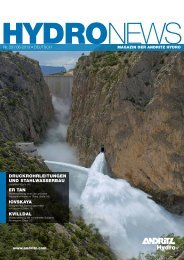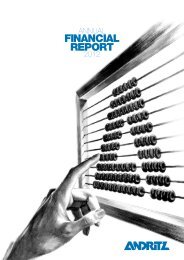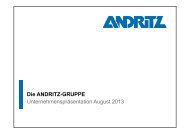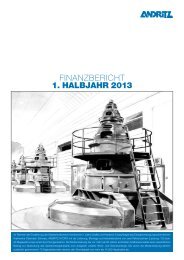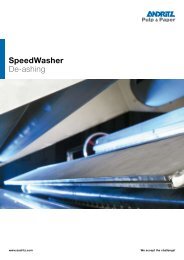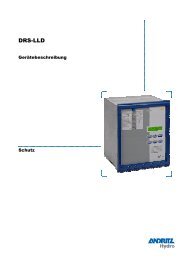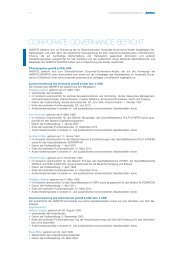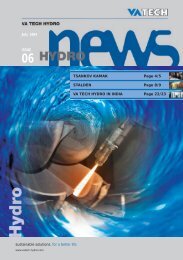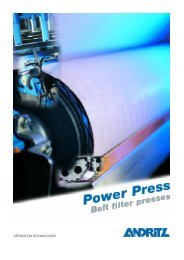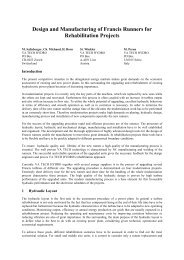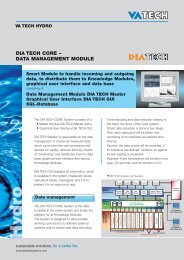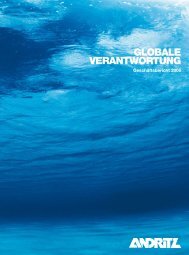Create successful ePaper yourself
Turn your PDF publications into a flip-book with our unique Google optimized e-Paper software.
10 11<br />
effective and compact – one-step solution<br />
Dry fl ue gas cleaning systems<br />
Our dry fl ue gas cleaning systems meet the requirements for complying with the world’s<br />
strictest emissions legislation, the desire for low consumption of additives, the need for<br />
minimal residues, and the installation simplicity of a compact design.<br />
ANDRITZ Energy & Environment’s dry flue<br />
gas cleaning technologies are based on<br />
two main applications:<br />
tuRBosoRP<br />
TURBOSORP is the ideal solution for flue<br />
gas cleaning downstream of biomass incinerations,<br />
RDF-fired boilers, or Energyfrom-Waste<br />
plants and other industrial applications.<br />
tuRBo-CDs<br />
TURBO-CDS is the right choice for flue gas<br />
cleaning downstream oil or coal-fired boilers.<br />
Process<br />
ANDRITZ Energy & Environment’s dry flue<br />
gas cleaning processes are based on wellproven<br />
circulating fluidized bed technology.<br />
The flue gas flows through a turboreactor<br />
from the bottom to the top and then enters<br />
a downstream particulate control device,<br />
which can be either a fabric filter or<br />
an electrostatic precipitator. Fly ash from<br />
incineration and fresh additives are dosed<br />
into the turboreactor, while a large part of<br />
the solid material from the reactor is fed<br />
back to the fluidized bed as recirculate.<br />
Water is also injected to lower the flue gas<br />
temperature and achieve higher separation<br />
performance.<br />
Water additives<br />
Raw gas<br />
Circulating Dry Scrubbing (CDS) process – TURBOSORP<br />
If needed, activated carbon serves to provide<br />
excellent heavy metal and dioxin removal.<br />
As a result of advanced process<br />
management with regard to the operational<br />
temperature, solids recirculation, and the<br />
dosed additives, material consumption and<br />
the quantities of residue are kept to a minimum.<br />
The product of the process is a dry,<br />
powdery residue which – depending on its<br />
composition – can be landfilled or used as<br />
a filler (e.g. road construction) after stabilization.<br />
Clean gas<br />
Low investment and<br />
maintenance cost<br />
TURBOSORP and TURBO-CDS systems<br />
are noteworthy for their compact designs.<br />
This allows for easier and lower cost installation<br />
in a plant. Fluidized bed technology<br />
does not employ rotating or wear parts, reducing<br />
the initial investment cost and the<br />
on-going maintenance costs. Due to the<br />
simplicity of the design of the system components,<br />
high levels of availability are typically<br />
achieved.<br />
Dry sorption<br />
In certain cases, especially for smaller<br />
plants and for optimized investments, a dry<br />
sorption process based on lime or sodi-<br />
um bicarbonate is an interesting alternative<br />
to CFB-based flue gas cleaning technology.<br />
The process features a reactor, where<br />
the dry powdered additive is injected and<br />
mixed with the flue gas, and a downstream<br />
fabric filter.<br />
sodium bicarbonate: for efficiency<br />
and low residue levels<br />
The sodium bicarbonate process is used<br />
wherever residue quantities must be kept<br />
as small as possible. Due to the very high<br />
reactivity of sodium bicarbonate, only a<br />
small amount of it is required. The process<br />
is virtually independent of temperature and<br />
maximizes energy recovery.<br />
Moerdijk, Netherlands<br />
Pratt, USA<br />
Key features<br />
Proven technology with excellent<br />
references<br />
Removal of all pollutants in one step<br />
(dust, SO , SO , HCl, HF, dioxines,<br />
2 3<br />
furanes, PCBs, heavy metals)<br />
Relatively low investment cost<br />
Compact design, easy retrofitting<br />
Simple aggregates, operation above<br />
dew point<br />
No corrosion, low maintenance<br />
High availability<br />
Low sorbent consumption due to<br />
recirculation<br />
High separation efficiency and low<br />
emissions<br />
Wastewater-free<br />
Compatible with low temperature<br />
SCR, no permanent reheating<br />
necessary



